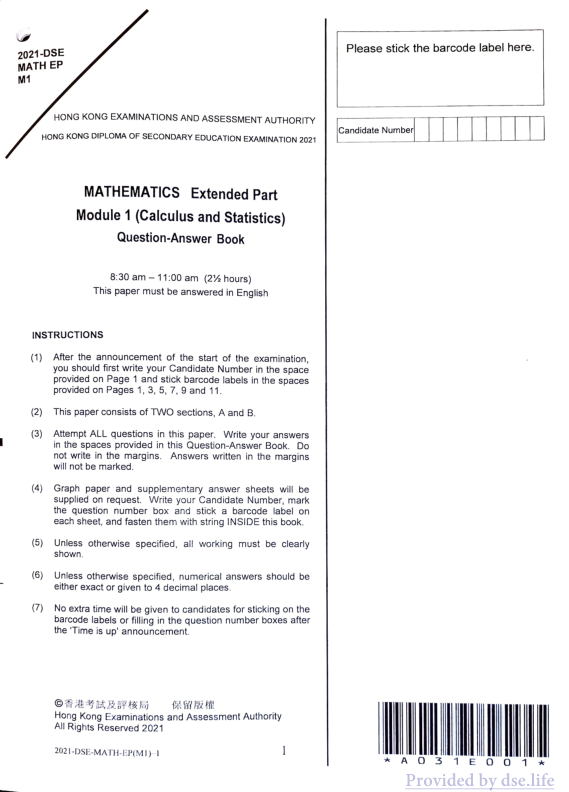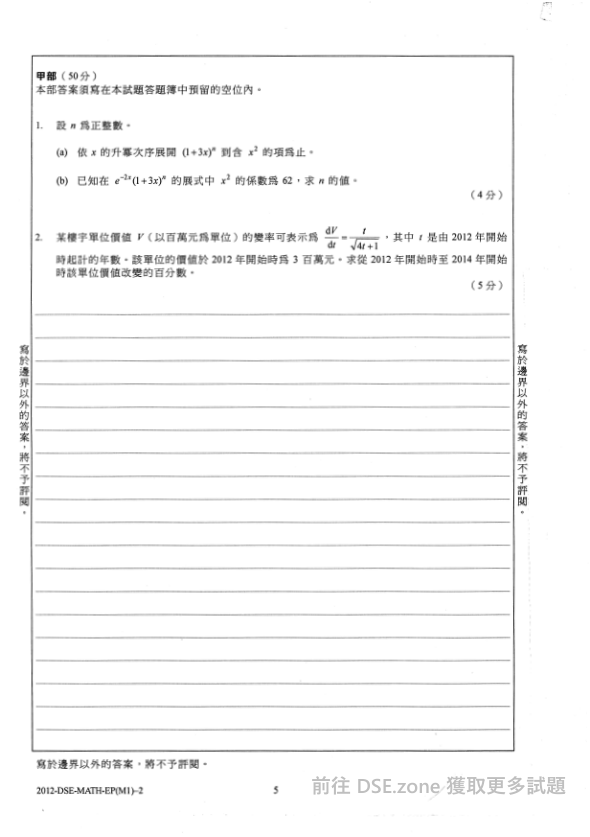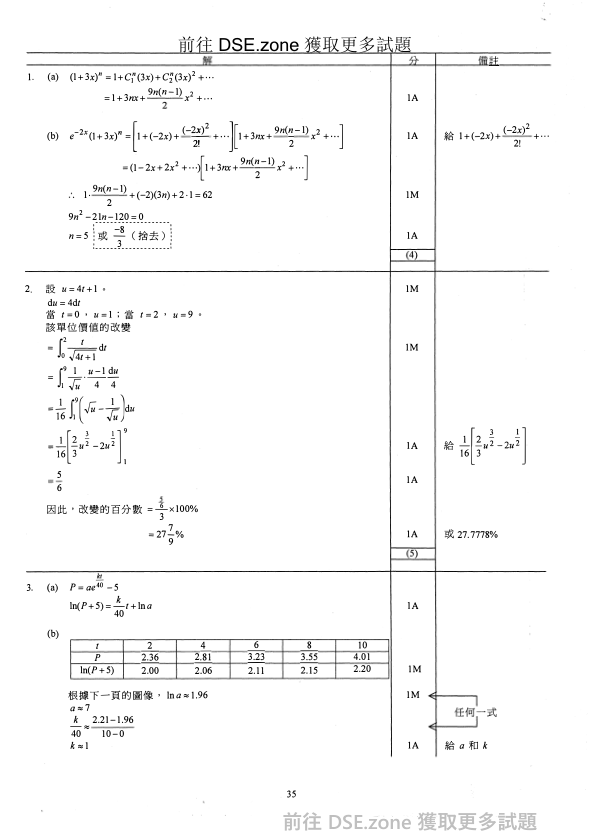2021 DSE 数学延伸部分-M1 真题 答案 详解
| 序号 | 文件列表 | 说明 | ||
|---|---|---|---|---|
| 1 | 2021-数学延伸部分-M1-paper-eng.pdf | 10 页 | 2.84MB | 真题(英文) |
| 2 | 2021-数学延伸部分-M1-paper-zh.pdf | 8 页 | 3.13MB | 真题(中文) |
| 3 | 2021-数学延伸部分-M1-answer-zh.pdf | 9 页 | 1.05MB | 答案(中文) |
| 4 | 2021-数学延伸部分-M1-answer-eng.pdf | 13 页 | 1.03MB | 答案(英文) |
真题(英文)
2021-DSE MATH EP M1
HONG KONG EXAMINATIONS AND ASSESSMENT AUTHORITY HONG KONG DIPLOMA OF SECONDARY EDUCATION EXAMINATION 2021
MATHEMATICS Extended Part Module 1 (Calculus and Statistics) Question-Answer Book
8:30 am – 11:00 am (2½ hours) This paper must be answered in English
INSTRUCTIONS
(1) After the announcement of the start of the examination, you should first write your Candidate Number in the space provided on Page 1 and stick barcode labels in the spaces provided on Pages 1, 3, 5, 7, 9 and 11.
(2) This paper consists of TWO sections, A and B.
(3) Attempt ALL questions in this paper. Write your answers in the spaces provided in this Question-Answer Book. Do not write in the margins. Answers written in the margins will not be marked.
(4) Graph paper and supplementary answer sheets will be supplied on request. Write your Candidate Number, mark the question number box and stick a barcode label on each sheet, and fasten them with string INSIDE this book.
(5) Unless otherwise specified, all working must be clearly shown.
(6) Unless otherwise specified, numerical answers should be either exact or given to 4 decimal places.
(7) No extra time will be given to candidates for sticking on the barcode labels or filling in the question number boxes after the 'Time is up' announcement.
© Hong Kong Examinations and Assessment Authority All Rights Reserved 2021
2021-DSE-MATH-EP(M1)-1
Please stick the barcode label here.
Candidate Number
A031E001
Provided by dse.life

真题(中文)
甲部(50分)
本部答案须寫在本試題答題簿中預留的空位內。
- 設n為正整數。
(a) 依x的升幂次序展開(1+3x)^n到含x^2的項為止。
(b) 已知在e^{-2x}(1+3x)^n的展式中x^2的係數為62,求n的值。(4分)
- 某樓字單位價值V(以百萬元為單位)的變率可表示為(\frac{dV}{dt}=\frac{t}{\sqrt{4t+1}}),其中t是由2012年開始時起計的年數。該單位的價值於2012年開始時為3百萬元。求從2012年開始時至2014年開始時該單位價值改變的百分數。(5分)
寫於邊界以外的答案,將不予評閱。
寫於邊界以外的答案,將不予評閱。
寫於邊界以外的答案,將不予評閱。
2012-DSE-MATH-EP(M1)-2 5 前往DSE.zone獲取更多試題

答案(中文)
前往DSE.zone獲取更多試題
- (a) $(1+3x)^n = 1 + C_n^1(3x) + C_n^2(3x)^2 + \cdots$ $= 1 + 3nx + \frac{9n(n-1)}{2}x^2 + \cdots$
分 備註
1A
(b) $e^{-2x}(1+3x)^n = \left[1 + (-2x) + \frac{(-2x)^2}{2!} + \cdots\right]\left[1 + 3nx + \frac{9n(n-1)}{2}x^2 + \cdots\right]$ $= (1 - 2x + 2x^2 + \cdots)(1 + 3nx + \frac{9n(n-1)}{2}x^2 + \cdots)$
1A
$\therefore 1 + \frac{9n(n-1)}{2} + (-2)(3n) + 2 \cdot 1 = 62$
1M
$9n^2 - 21n - 120 = 0$
$n = 5$ 或 $\frac{-8}{3}$(捨去)
1A
(4)
- 設 $u = 4t + 1$。
$du = 4dt$
當 $t = 0$,$u = 1$;當 $t = 2$,$u = 9$。
該單位價值的改變
$= \int_{0}^{2}\frac{t}{\sqrt{4t+1}}dt$
$= \int_{1}^{9}\frac{1}{\sqrt{u}}\cdot\frac{u-1}{4}du$
$= \frac{1}{16}\int_{1}^{9}\left(\sqrt{u}-\frac{1}{\sqrt{u}}\right)du$
$= \frac{1}{16}\left[\frac{2}{3}u^{\frac{3}{2}}-2u^{\frac{1}{2}}\right]_1^9$
$= \frac{5}{6}$
因此,改變的百分數 $=\frac{5}{6}\times100\%$
$=27\frac{7}{9}\%$
1M
1A
1A
1A
或 $27.7778\%$
(5)
- (a) $P = ae^{\frac{k}{40}t} - 5$
$\ln(P + 5) = \frac{k}{40}t + \ln a$
(b)
| t | 2 | 4 | 6 | 8 | 10 |
|---|---|---|---|---|---|
| P | 2.36 | 2.81 | 3.23 | 3.55 | 4.01 |
| ln(P + 5) | 2.00 | 2.06 | 2.11 | 2.15 | 2.20 |
根據下一頁的圖像,$\ln a \approx 1.96$
$a \approx e^{1.96}$
$\frac{k}{40} \approx \frac{2.21 - 1.96}{10 - 0}$
$k \approx 1$
1A
1M
1M
給 a 和 k
35
前往 DSE.zone 獲取更多試題

答案(英文)
Marking Scheme
Module 1 (Calculus and Statistics)
This document was prepared for markers' reference. It should not be regarded as a set of model answers. Candidates and teachers who were not involved in the marking process are advised to interpret its contents with care.
General Marking Instructions
-
It is very important that all markers should adhere as closely as possible to the marking scheme. In many cases, however, candidates will have obtained a correct answer by an alternative method not specified in the marking scheme. In general, a correct answer merits all the marks allocated to that part, unless a particular method has been specified in the question. Markers should be patient in marking alternative solutions not specified in the marking scheme.
-
In the marking scheme, marks are classified into the following three categories:
- 'M' marks awarded for correct methods being used;
- 'A' marks awarded for the accuracy of the answers;
- Marks without 'M' or 'A' awarded for correctly completing a proof or arriving at an answer given in a question.
In a question consisting of several parts each depending on the previous parts, 'M' marks should be awarded to steps or methods correctly deduced from previous answers, even if these answers are erroneous. However, 'A' marks for the corresponding answers should NOT be awarded (unless otherwise specified).
-
For the convenience of markers, the marking scheme was written as detailed as possible. However, it is still likely that candidates would not present their solution in the same explicit manner, e.g., some steps would either be omitted or stated implicitly. In such cases, markers should exercise their discretion in marking candidates' work. In general, marks for a certain step should be awarded if candidates' solution indicated that the relevant concept/technique had been used.
-
In marking candidates' work, the benefit of doubt should be given in the candidates' favour.
-
In the marking scheme, 'r.t.' stands for 'accepting answers which can be rounded off to' and 'f.t.' stands for 'follow through'. Steps which can be skipped are shaded whereas alternative answers are enclosed with rectangles. All fractional answers must be simplified.
-
Unless otherwise specified in the question, numerical answers should either be exact or given to 4 decimal places. Answers not accurate up to the required degree of accuracy should not be accepted.
56 Provided by dse.life

